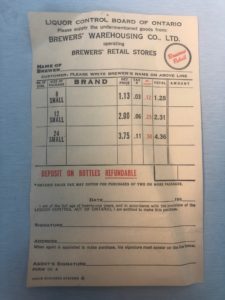 Here we are. Real spring. No more frozen nights on the forecast. Brussels sprout seeds are in some soil. The cardoons are up. Cardoons? Yup, cardoons. Four foot tall edible thistles, a Victorian veg. Harry Dobson would be proud. Still rather insulated from the exterior world by my convalescent state but I am assured things are progressing as they should. It was April Fool’s Day last Friday. Best beery April Fools? This is my candidate. Silly but also somewhat restrained. What people might have actually asked about having once in a while, as a joke… as a… what… treat? A good brand making fun of itself. That’s a good thing, making fun. Like this! Fun!
Here we are. Real spring. No more frozen nights on the forecast. Brussels sprout seeds are in some soil. The cardoons are up. Cardoons? Yup, cardoons. Four foot tall edible thistles, a Victorian veg. Harry Dobson would be proud. Still rather insulated from the exterior world by my convalescent state but I am assured things are progressing as they should. It was April Fool’s Day last Friday. Best beery April Fools? This is my candidate. Silly but also somewhat restrained. What people might have actually asked about having once in a while, as a joke… as a… what… treat? A good brand making fun of itself. That’s a good thing, making fun. Like this! Fun!
Now, enough of that. Time to get serious. First up, care of Merryn, we learn that the BBC has reported on a Roman brewing site found in England, with speculation that it was actually only a malting with suggestions of a rather complex brewing industry:
Archaeologists have identified evidence of 2,000-year-old beer production at a site of a road improvement scheme. The remains of a Roman malting oven and charred spelt grains were found during digging in Bedfordshire, as part of the proposed work on the A428 between the Black Cat roundabout and Caxton Gibbet. Experts have analysed the grains and said they suggested people who lived there were involved in making beer…”As large quantities of grains are only allowed to germinate when the aim is to produce malt – the first step in the brewing process – this strongly suggests the people living at the settlement were involved in beer production,” a Mola spokesperson said.
 Some serious neato going on there. Also neato? A map! This is an interesting info graphic. Who asks this question? I suppose health professionals. Utah makes sense but look at the dividing line between West Virginia and Pennsylvania. The Florida panhandle and Alabama. Why? I have not idea. I am Canadian.
Some serious neato going on there. Also neato? A map! This is an interesting info graphic. Who asks this question? I suppose health professionals. Utah makes sense but look at the dividing line between West Virginia and Pennsylvania. The Florida panhandle and Alabama. Why? I have not idea. I am Canadian.
Pellicle posted one of the best articles it has ever had its hands on this week, a tale of tall ales titled “I Want To See Mountains Again — The Banked Beers of Teesside, North East England” by Reece Hugill:
Half-full glasses are pulled from the bar-back fridge, topped up feverishly from the hand-pull. Placed in front of me are two ridiculous looking pints of ruby-red cask beer. Foam cartoonishly mounded a full four inches higher than the brim of the glass. Wobbling and bubbling, alpine peaks and whips of pure white…
…The pints of Bass at the Sun Inn are magic. It’s a beer I usually don’t even like, but when banked, the beer seems to change a tiny bit. The fluffy head brings out a little more bitterness, the body is mellowed into something less vaguely malty and brown, into something soft and clean, like, perhaps, an unusual dunkel lager…
Excellent. You could do this with an Olands Ex back in college but it was a matter of pouring the bottle yourself.
Lars posted a really good thread about Christmas “sugar beer” for children in Norway including this fabulous if fairly frightening fact:
This newspaper article is quite illustrative. Headline: “The favourite beer of the kids.” They use 3kg sugar for 20l + 1/2 cup of malt extract. If you ferment it out fully that’s 8% ABV. No wonder “the kids prefer this to any soft drink.” Prob not 100% fermented, but still.
Question: is this a new technique? Holding some of the dry malt in a dry aromatic barrel?
In the increasingly vibrant world of beer related litigation, we have (care of Mike Kanach, Esq.) learned on one Mr. Parshall “who does business as Sports Beer Brewing Co. that is operated through a website” – court said this about his business:
Parshall is required to transfer to the university all Internet domain names containing a portion or derivative of Penn State’s marks. He also is to transfer sportsbeerbrewing.com so it ceases operation. The injunction prevents Parshall from engaging in any conduct that would cause consumers to erroneously believe his goods and services are authorized, licensed or affiliated with Penn State.
That is just weird. Took a university’s IP and put it on a beer can. In 2017 he did the same thing with Purdue and another judge did pretty much the same thing. Self-represented. Weird.
Not as weird, Stone now seeks a permanent injunction despite the Keystone brand lords announcing a remake after five years. With any luck they’ll find a new way to jerk Stone around. And mid-weird, the little and large tale of BrewDog and the not quite hired consultant* continues and even made The Times of London. This passage neatly captures the two aspects which have confused me:
Allan Leighton, BrewDog’s chairman and the former boss of Asda, has accused Hand & Heart of “amplifying attacks” on its management team and has declined to take part in a proposed reconciliation programme. In a letter to Kate Bailey, Hand & Heart’s managing director, Leighton said he was concerned about a platform that had been set up for BrewDog workers, claiming it was “encouraging participants to submit malicious content . . . The unavoidable impression is that of H&H charging the company to extinguish a fire it is fuelling itself.”
On the other hand, BrewDog apparently continued to shoot itself in the foot without the assistance of others, rolling out a quote from the consultant that they did actually hire… only for that consultant to point out they never said any such thing. Weird.
 This was a fabulous find as posted on Twitter by Mr. S. Smith, a mint 1960s form to fill out and pass over the counter at a Brewers Retail store in Ontario. A buck twenty eight for a dink pack. Until 1969, you had to give your name and an address to get your beer. Presumably you filled out the last line by hand if you were buying quarts. Crain Business Systems must have made a killing on this contract seeing as this was the only way in Canada’s biggest province to buy beer outside of a sit down establishment.
This was a fabulous find as posted on Twitter by Mr. S. Smith, a mint 1960s form to fill out and pass over the counter at a Brewers Retail store in Ontario. A buck twenty eight for a dink pack. Until 1969, you had to give your name and an address to get your beer. Presumably you filled out the last line by hand if you were buying quarts. Crain Business Systems must have made a killing on this contract seeing as this was the only way in Canada’s biggest province to buy beer outside of a sit down establishment.
Finally but fabulously, Beth published her latest edition of Prohibitchin’ (sign up here) and featuring (i) Ashley Johnson and Jasmine Mason bringing cider to Philadelphia along with first (i) this bit of local slang they had adopted in their business’s name – The Cider Jawns:
“Jawn” /jôn/: Philadelphia slang that’s used as an all-purpose substitute for literally anything—a singular or plural person, place, thing, or event that can’t be specifically described…
Jasmine and Ashley are having the time of their jawns. Or is it the jawn of their lives? …“We looked around and a lot of the attendees were women, but there weren’t a lot of women of color as vendors,” explains Jasmine. Ashley agrees, noting that while there wasn’t much diversity in vendors, there were plenty of Black women and other women of color enjoying themselves as attendees. The discrepancy spurred them to action. “We were inspired to take something we enjoyed and bring representation of women of color to the hard cider and brewing industries,” says Ashley. They launched their Cider Jawns Instagram shortly after to “share our cider journey and take our community along for the ride,” she says.
There. Blame all the errors on the meds. For more, checking out the updates from Boak and Bailey mostly every Saturday and from Stan every Monday, plus more with the weekly Beer Ladies Podcast, and at the weekly OCBG Podcast on Tuesday and sometimes on a Friday posts at The Fizz as well. There is a monthly sort of round up at The Glass. (Ed.: that seems to be dead now.) There is more from DaftAboutCraft‘s podcast, too. And the Beervana podcast. And sign up for Katie’s irregular newsletter, The Gulp, too. And check out the Atlantic Canada Beer Blog‘s weekly roundup. Plus follow the venerable Full Pint podcast. And Fermentation Radio with Emma Inch. The AfroBeerChick podcast as well! And also look at Brewsround and Cabin Fever. And Ben has his own podcast, Beer and Badword (Ed.: …notice of revival of which has been given…) And remember BeerEdge, too, and The Moon Under Water.

The interest in beers with large heads is just a return, or reminder, of practices long associated with the beer culture internationally.
There are thousands of examples, but the glasses in the links below are illustrative. The first is an essay by a Purdue doctoral student examining temperance artifacts in Purdue archives. The second is a stock photo from Alamy (that rather gives point to your jape about Oland Export).
In both one can see a kind of Teeside banking. Beer is still served like this at McSorley’s in New York, another example.
Generous foam was probably meant originally to reduce excess carbonation, as in weizen beer service or weisse in Berlin. Ditto the lavish foam of the big mugs at Oktoberfest. One sees an echo of these practices in early German-American beer culture.
Later I think an aesthetic element was perceived, the contrast of white against gold, amber, brown, etc.
There is also too the idea of permissible excess, a visual counterpart to the festive abandon often associated with beer cultures.
https://omeka.cla.purdue.edu/s/investigating-150-years/page/alcohol-prohibition-in-1930s
https://www.alamy.com/1940s-laughing-older-man-in-suit-and-tie-looking-at-camera-winking-lifting-a-glass-of-beer-with-a-good-foamy-head-in-a-toast-f655-har001-hars-1-lifting-welcome-communication-laugh-balance-pleased-joy-lifestyle-celebration-elder-home-life-friendship-half-length-persons-inspiration-males-confidence-senior-man-senior-adult-middle-aged-bw-winking-middle-aged-man-eye-contact-success-suit-and-tie-selling-happiness-old-age-oldsters-cheerful-oldster-beverage-toast-and-choice-excitement-low-angle-recreation-pride-a-in-of-authority-smiles-elders-connection-conceptual-joyful-stylish-foamy-relaxation-image437603668.html
I do but it is not that simple. I self-identify (among other things like Nova Scotian (but only having lived there from 1970 to 1991, from grade 1 to end of law school) as a Scottish-Canadian in the sense that my pal is an Italian-Canadian but we are both by society included in the category of English Canadians in that the first language we speak, primarily to distinguish the majority of Canadians from Quebeckers and Acadians who are categorized as French Canadians. Simple!